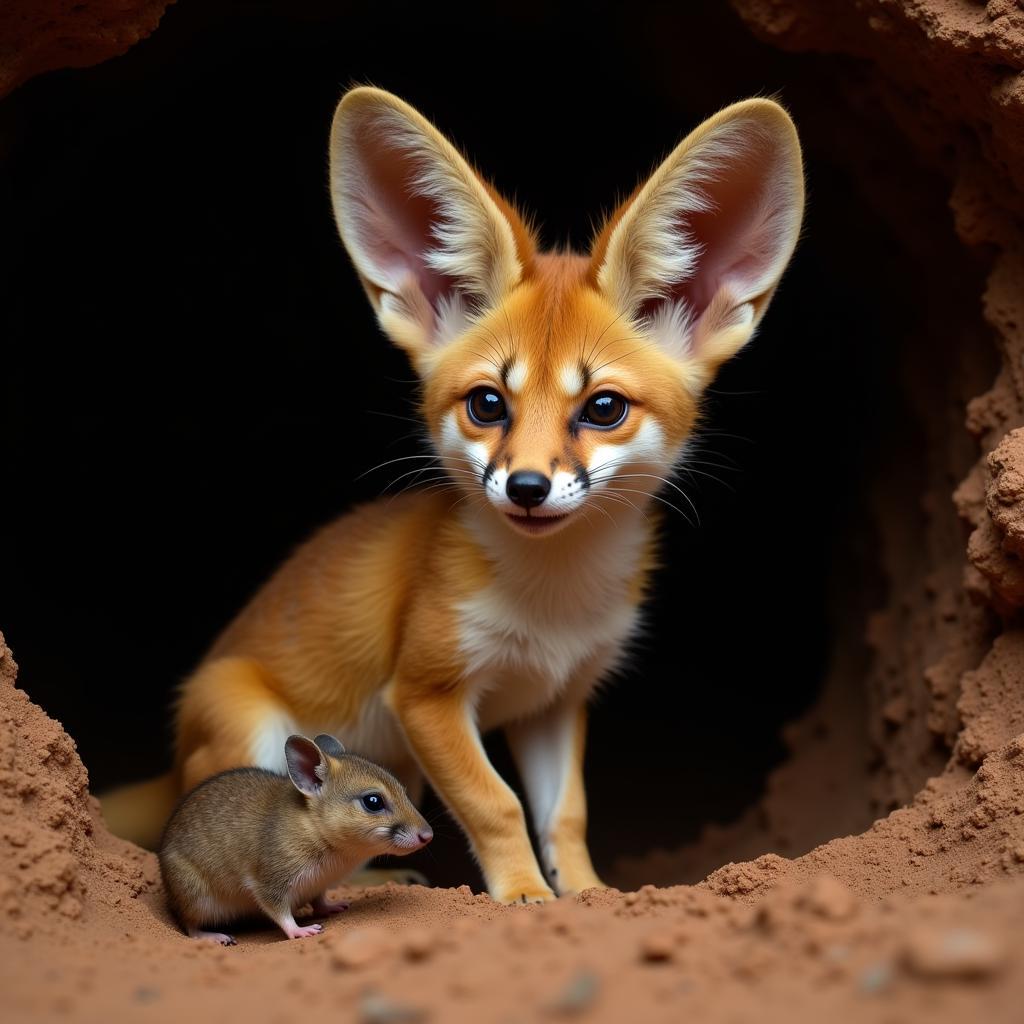African Desert Wildlife: A Glimpse into a World of Resilience
The African desert, a landscape of scorching sun and shifting sands, may seem inhospitable at first glance. Yet, beneath the harsh exterior lies a vibrant ecosystem teeming with unique and resilient wildlife. These creatures, from towering mammals to tiny insects, have adapted to thrive in this challenging environment.
Enduring the Extremes: Adaptations of African Desert Wildlife
Survival in the desert is a delicate balancing act. Animals face relentless heat, limited water sources, and scarce food options. Over millennia, African Desert Wildlife has evolved remarkable adaptations to conquer these challenges.
Mastering Thermoregulation: Keeping Cool Under the Desert Sun
 Fennec fox panting in the Sahara Desert
Fennec fox panting in the Sahara Desert
One of the most critical adaptations is the ability to regulate body temperature. The scorching heat can be deadly, so desert animals have developed ways to stay cool. Some, like the iconic fennec fox, have large ears with extensive blood vessels that radiate heat away from the body. Others, like the desert oryx, have light-colored coats that reflect sunlight and minimize heat absorption.
Water Conservation: Thriving in Arid Lands
Water scarcity is a defining feature of desert life, and animals have evolved ingenious methods to conserve this precious resource. Many desert dwellers, like the Addax antelope, obtain most of their water from the food they consume. Their specialized kidneys efficiently extract moisture from plants, minimizing water loss. Others, like the desert hedgehog, have adapted to survive on minimal water, even resorting to metabolic water production from their food.
 A group of oryx gathered around a watering hole in the Namib Desert
A group of oryx gathered around a watering hole in the Namib Desert
Navigating the Sands: Locomotion and Foraging Strategies
The desert landscape presents unique challenges for movement and foraging. Loose sand and vast distances require specialized adaptations.
Masters of the Dunes: Adaptations for Movement
Many desert animals, like the sand viper, have evolved a sidewinding motion that allows them to effortlessly glide across loose sand. This unique locomotion minimizes contact with the hot surface, reducing heat absorption. Some animals, like the jerboa, have elongated hind limbs, enabling them to cover vast distances with impressive leaps. This is crucial for both predator evasion and efficient foraging.
Finding Sustenance: Desert Foraging Techniques
Food is often scarce and scattered in the desert. Many animals, like the fennec fox, are opportunistic feeders, consuming a wide range of insects, reptiles, and even plant matter. Others, like the desert locust, have adapted to exploit sporadic food sources. They can travel vast distances in swarms, devouring vegetation wherever it’s available.
 An African desert fox hunts a gerbil at night.
An African desert fox hunts a gerbil at night.
A Delicate Balance: The Future of African Desert Wildlife
As we marvel at the resilience of African desert wildlife, it’s crucial to acknowledge the threats they face. Climate change, habitat loss, and poaching are pushing many species towards a precarious future. Conservation efforts are vital to ensure these incredible creatures continue to thrive in their harsh yet beautiful home.
Do you want to explore more about specific creatures of the African desert? Check out our african desert fox crossword for a fun and engaging way to test your knowledge!
FAQs about African Desert Wildlife
1. What is the hottest desert in Africa?
The hottest desert in Africa, and the world, is the Sahara Desert. Temperatures can soar to a blistering 136 degrees Fahrenheit (58 degrees Celsius).
2. How do camels survive in the desert?
Camels have numerous adaptations, including their humps that store fat (not water as commonly believed), the ability to go for long periods without water, and efficient water extraction from their food.
3. Are there any large predators in African deserts?
Yes, African deserts are home to predators like cheetahs, lions (in limited areas), leopards, and hyenas. These animals have adapted to survive in the harsh conditions.
4. What can we do to help protect African desert wildlife?
Supporting conservation organizations, promoting responsible tourism, and raising awareness about the threats facing these animals are crucial steps to protect them.
5. Are there any poisonous animals in the African desert?
Yes, several poisonous creatures inhabit African deserts, including scorpions, vipers, and spiders. It’s essential to be cautious and avoid disturbing these animals.
Discover more about Africa
Want to delve deeper into the wonders of Africa? Explore our other articles:
- African desert facts: Uncover fascinating details about the geography, climate, and cultural significance of African deserts.
- African adventure movies: Immerse yourself in the thrill of Africa through captivating films set against the backdrop of its stunning landscapes.
Contact us for further assistance at +255768904061, email us at [email protected], or visit our office located in Mbarali DC Mawindi, Kangaga, Tanzania. We are available 24/7 to assist you.


